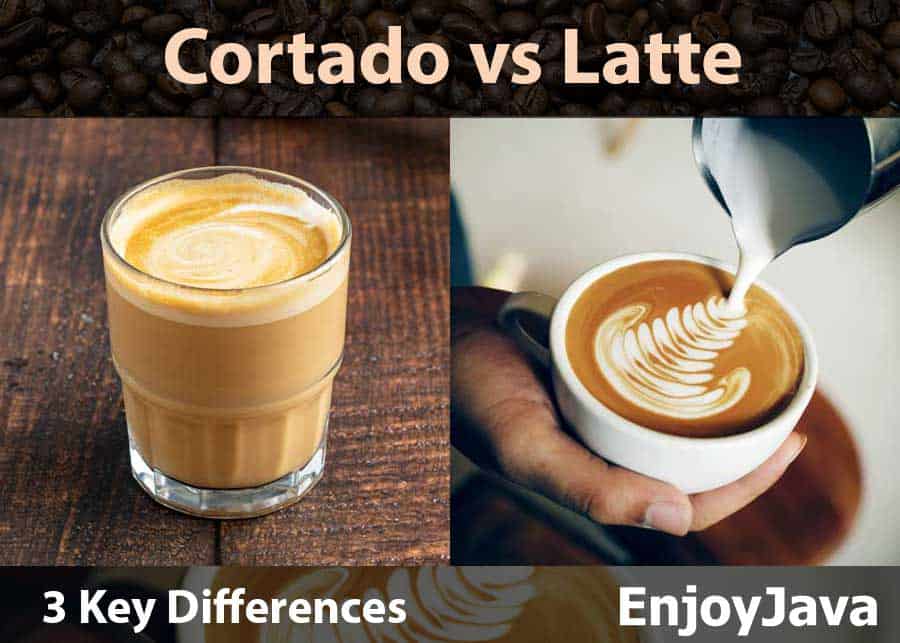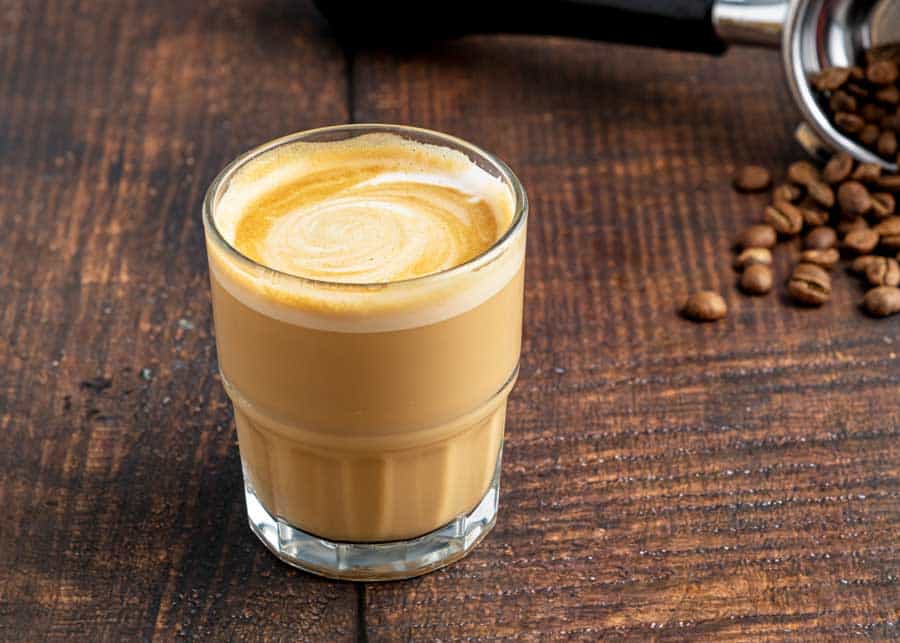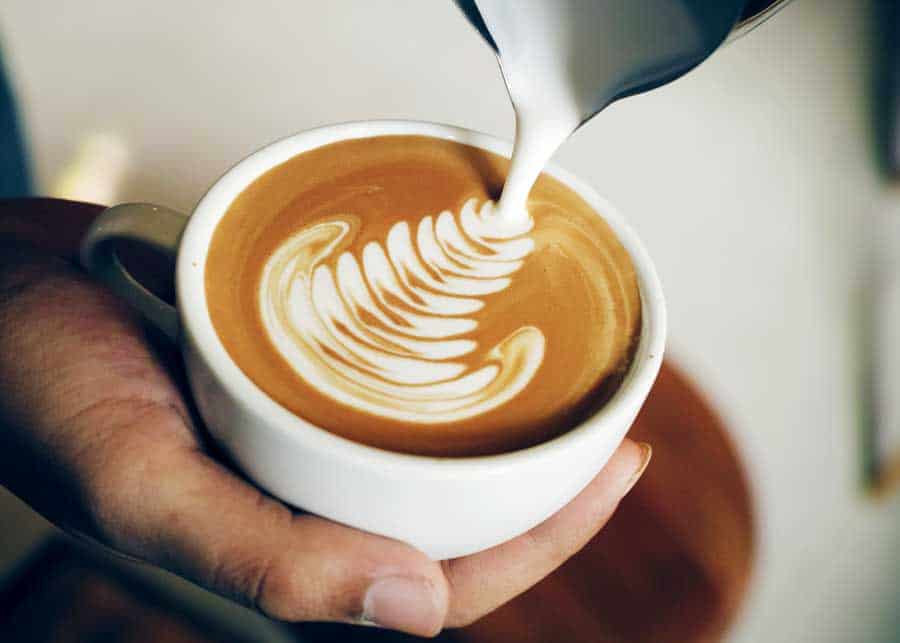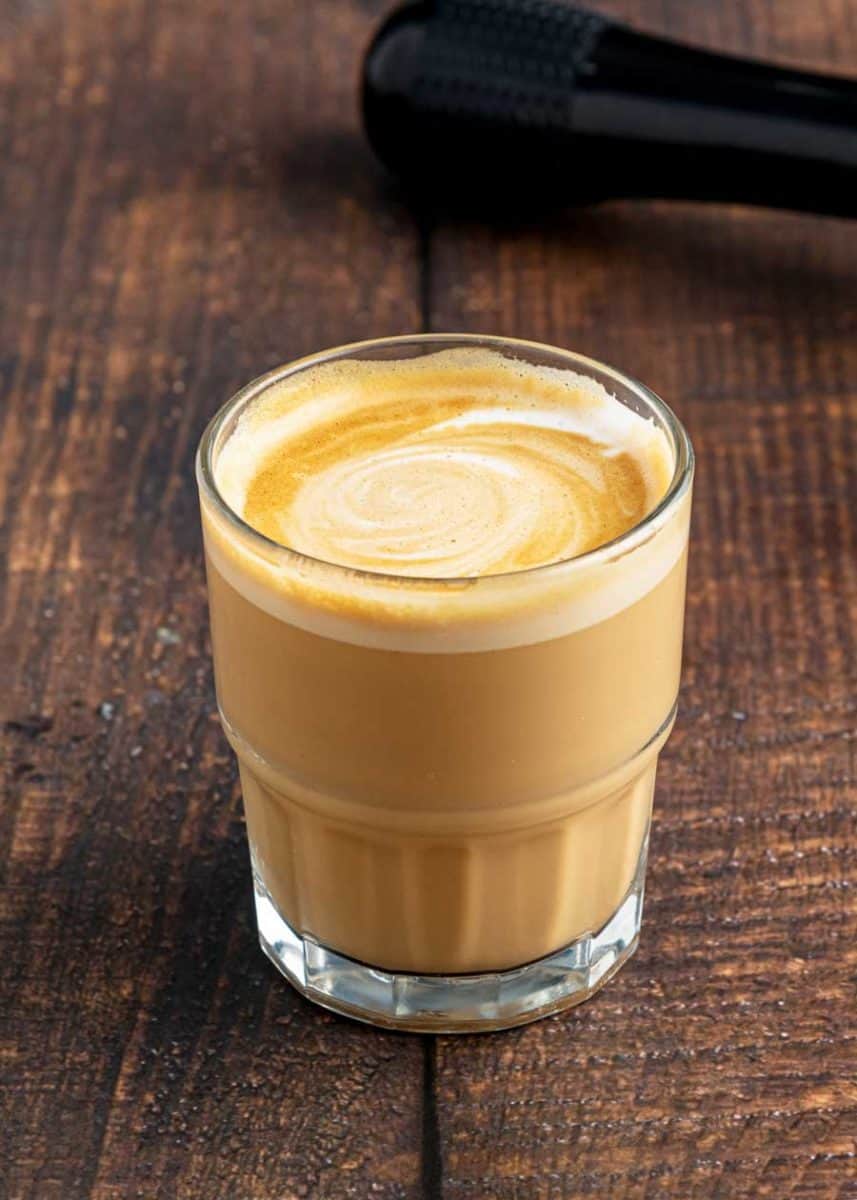Have you tried a cortado? At many coffee shops, cortado coffee is a little rarer than a latte. Even many coffee aficionados don’t know the difference between the cortado vs latte. The differences include sweetness, origins, and brew methods.
Cortado is a 1:1 ratio of espresso and steamed milk. The serving size is smaller and much less sweet. Latte is ⅓ espresso, ⅔ steamed milk, and topped with a thick layer of milk foam. It has a distinct, frothy texture and tastes sweeter.
Cortado originated in Spain, while lattes originated in Italy.

If you’ve ever stared up at your local coffee shop’s menu and wondered what the difference between a cortado and a latte was, you needn’t wonder any longer.
Read on for more about these delicious coffee beverages and their key differences.
3 Differences: Latte vs. Cortado
The difference between cortado coffees and lattes is their origin, brew method, and overall taste.
The main differences to remember are:
- Cortado is a 1:1 ratio of espresso and steamed milk. The serving size is smaller and less sweet.
- Latte is ⅓ espresso, ⅔ steamed milk, and topped with a thick layer of milk foam. It has a distinct, frothy texture and is often made sweet.
What is a Cortado?
When it comes time to choose between a cortado coffee vs. latte, more and more coffee drinkers are transitioning to the lesser-known cortado.
Although it isn’t as recognizable as a latte, a cortado is a small, delicious espresso-based coffee that gives a nice caffeine kick.

Origin of Cortado (Spain)
A cortado is a Spanish, Portuguese, and Latin American drink made popular in the 1960s.
The word cortado comes from the Spanish word “cortar” which means “to cut.” The name describes how the bitter, highly-acidic espresso is diluted or cut with sweet, steamed milk.
Here’s how to order coffee in Spanish.
Brew Method
A traditional cortado is made with equal parts espresso and steamed milk. Usually, a double shot of espresso is used. Unlike a latte, the steamed milk in a cortado does not have a frothy texture. Instead, cortado coffee is smoothly blended.
A normal U.S. serving size for a cortado is around 4 ounces.
There is around 130mg of caffeine present. This amount is the same as a 12 ounce latte and provides a nice jolt of caffeine. Unfortunately, a cortado is significantly smaller which means there is less to enjoy.
Taste & Variations
Cortados have an extremely smooth, soft, and silky texture. They also have a much stronger espresso flavor than a latte. The result is a supremely balanced beverage where all of the present flavors play together nicely.
Cortados do not normally have added spices or syrups.
There are common variations of the cortado, each with slightly different flavor profiles.
- In Spain, cortado condensada is a cortado variation made with steamed condensed milk. Condensed milk is much sweeter than plain milk.
- The cortadito, which originated in Cuba, is the most well-known. It consists of sugar whipped with a single shot of espresso and topped with condensed milk. The result is a sweet dessert-like drink that tastes like coffee and caramel.
What is a Latte?
Lattes have long been a go-to espresso coffee order for caffeine fiends across the globe. They are mild coffee beverages that suit a variety of palettes, and they are easily customizable.
According to the National Coffee Association (NCA), lattes are among the most popular coffee drinks in the United States.
They are the most popular amongst 25-39-year-olds and Asian-Americans.

Origin of Latte (Italy)
The caffe latte, or latte for short, is an espresso-based drink from Italy. The term coffee latte in Italian translates to coffee and milk, which are the building blocks of a traditional latte.
The latte’s past is a bit murky, and no one can say for sure what individual created it. However, the term “caffe latte” first appears in an 1867 essay by William Dean Howell.
The latte is similar to the French “cafe au lait,” coffee brewed with hot milk. Here’s more about ordering coffee in France.
Here’s how to order coffee in Italy.
Brew Method
Lattes are usually made with a double shot of espresso and between 8 to 10 ounces of steamed milk layered overtop. The topmost layer of milk foam is thin and has a smooth texture.
Lattes are a treat that can be enjoyed hot or over ice. They can also be made with milk alternatives like almond or oat milk, although the drink’s signature milk foam texture isn’t as apparent as it is with whole milk.
A standard-sized latte contains around 130mg of caffeine. This amount is safely under the recommended daily caffeine limit of 400mg for adults.
Taste
The combination of espresso, steamed milk, and foam creates a frothy, creamy beverage with an exquisite mouthfeel. The majority of the drink is milk, so the bitter espresso taste is relatively mild. When the milk is steamed, the resulting texture coats the tongue and mouth for extra flavor.
Flavored lattes are especially popular amongst coffee fans. Latte lovers often request the addition of hazelnut, mocha, vanilla, and pumpkin spice to elevate and sweeten their drink.
Common flavor add-ons like cocoa powder or cinnamon would be sprinkled on the milk foam before syrups were a common fixture in lattes.
Learn more about other types of coffee.

Takeaway
The debate between cortado coffee vs. latte and which is better comes down to personal preference. Both are espresso-based coffee drinks that contain steamed milk, but the flavor and texture profiles are quite different.
If you are craving a milk-forward beverage with a mild espresso taste, good flavor, and unique texture, a latte is an excellent choice. A latte is also going to be much larger.
On the other hand, if you are in the mood for a small burst of caffeine and a strong espresso flavor, you may want to order a cortado instead.
- About the Author
- Latest Posts
Dena Haines is a co-founder and blogger on EnjoyJava – and is working to make it the best coffee blog in the world.
She also blogs about travel at Storyteller.Travel and photography at Storyteller Tech. Dena is a partner at Storyteller Media, a publishing company she started with her husband, Bryan.
